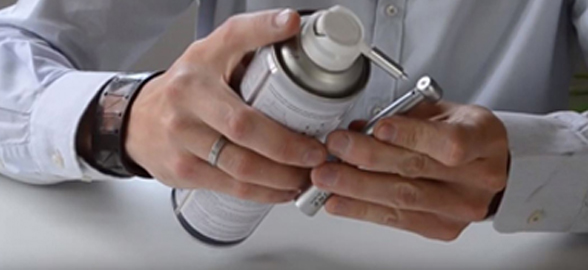Handpieces are one of the most vital elements in dentistry. Because of this, at Dentaltix, we want to help you choose the right handpiece for your clinic.
Before getting stuck in, it's important to remember that the dental handpiece is a low-speed rotary instrument that can go from 20.000 to 40.000 revolutions per minute. This instrument is generally used in the mouth for retouching dentures and is often paired with a micro-motor. They have multiple applications in endodontics, implantology and dentistry in general, so having a comfortable handpiece is essential.
What should be taken into account when choosing a handpiece?
When it comes to acquiring a handpiece, there are 4 important features to consider:
- The type of propulsion: air or electric.
- Lighting: with or without light.
- Cleaning and maintenance.
Types of propulsion of handpieces
Air propulsion :The micro-air motor drives the handpiece, transmitting power through a rotor on which the compressed air acts. These propulsion systems reach a maximum speed of 25.000 revolutions per minute.
Air handpieces use air energy to create rotary motion. This technology has been used for years because it is very easy to use. As a result, many manufacturers have increased the quality of their products and reduced their price. Some of its most outstanding features:
- They are lighter.
- They are more manageable and easier to control than electric ones.
- They have greater accessibility, they are usually more compact, which allows better access to difficult areas of the mouth.
- They reduce fatigue, thus providing a better user experience.
- They have a much more sensitive work process, since you can even “hear” the contact of the drill with the tooth.
- They have a higher speed but less touch compared to electric handpieces.
- When the piece comes into contact with the tooth, the resistance increases and the speed decreases.
Electric propulsion: Electric micro-motors reach an idle speed of up to 40.000 rpm. Unlike compressed air, it allows almost constant speed, regardless of the load. This ensures that the cutting speed does not sow down during the preparation process when the bur comes into contact with the tooth structure or prothesis.
Many people are hesitant to start using electric handpieces, as they have a steep learning curve. These handpieces use an electric motor to create the rotary motion of the drills, which makes them a bit heavier and therefore increases fatigue. In addition, if used by a professional with little experience, it can increase the risk of increasing pressure on the tooth. However, they do have some advantages:
- They have a very constant torque that does not decrease with resistance.
- They produce a smoother and more precise cut.
- The constant speed can be between 1,000 and 40,000 rpm.
- Many electric handpieces allow you to control torque and low speed and do an ENDO preparation.
- The diameter of the head is a little smaller, so the viewing angle is much better.
- Patients often prefer this model because they are quieter and do not produce as much vibration.
- In addition, electric motors today are equipped with LED lights, which gives a further advantage.
Handpieces with or without light?
In any odontological treatment, good lighting is fundamental. As a result, since 2007, some instruments have incorporated the use of LED lighting, a major development in the dental sector.
The handpieces without lighting are generally cheaper than the models without integrated light, but they make the dentist's work much easier.
Cleaning and maintenance
Never forget to clean your dental handpiece! To meet all hygiene requirements, dental handpieces, turbines and motors must be sterilised after each patient. This is why it's very important that the instruments can be separated easily and quickly, so that you don't waste unnecessary time and can use it more effectively to manage your dental practice instead.
To extend the life of your handpieces, we recommend that the sterilisation process does not exceed the maximum advisable temperatures. The best option in this case is a Class B professional autoclave, as they treat the material carefully and reliably. At Dentaltix, we provide you with some guidelines for choosing the best class B autoclave.
It is also important to point out some aspects that you can also take into account when buying a handpiece, such as the transmission (direct or multiplier) or if the dental handpiece is for general use or for surgeries, since the general one should never be used for surgeries as they would end up being damaged or even rusting.
We invite you to read our article "Tips for the maintenance of rotary instruments in your dental practice" for more details on cleaning and maintaining rotary instruments, where you will find practical recommendations and step-by-step guides to ensure maximum durability and performance of your tools.
Our recommendations for dental handpieces
We hope that all these tips will help you in the difficult task of choosing the most suitable handpiece. At Dentaltix, there's a wide range of dental handpieces in our online catalogue, so that you can find the one that best suits your needs and your budget. If you have any questions or suggestions, we are just here!





